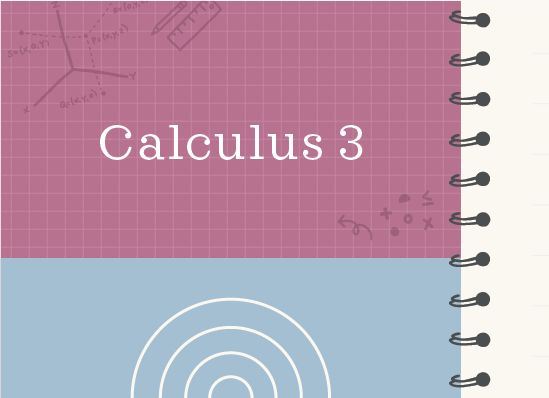How to find the unit tangent and unit normal vectors of a vector function
Formulas for the unit tangent and unit normal vectors
The unit tangent vector ???T(t)??? of a vector function
???r(t)=r(t)_1\bold i+r(t)_2\bold j+r(t)_3\bold k???
is the vector that is ???1??? unit long and tangent to the vector function at the point ???t???.
???T(t)=\frac{r'(t)}{\left|r'(t)\right|}???
Hi! I'm krista.
I create online courses to help you rock your math class. Read more.
Remember that ???\left|r'(t)\right|??? is the magnitude of the derivative of the vector function at time ???t???, and we can find it using the formula
???\left|r'(t)\right|=\sqrt{\left[r'(t)_1\right]^2+\left[r'(t)_2\right]^2+\left[r'(t)_3\right]^2}???
The unit normal vector ???N(t)??? of the same vector function is the vector that is ???1??? unit long and perpendicular to the unit tangent vector at the same point ???t???.
???N(t)=\frac{T'(t)}{\left|T'(t)\right|}???
Remember that ???\left|T'(t)\right|??? is the magnitude of the derivative of the unit tangent vector at time ???t???, and we can find it using the formula
???\left|T'(t)\right|=\sqrt{\left[T'(t)_1\right]^2+\left[T'(t)_2\right]^2+\left[T'(t)_3\right]^2}???
How to find the unit tangent vector and unit normal vector, step-by-step
Take the course
Want to learn more about Calculus 3? I have a step-by-step course for that. :)
Finding the unit normal vector at a particular point
Example
Find the unit normal vector of the vector function at ???t=1???.
???r(t)=t\bold i+t^2\bold j+2\bold k???
In order to find the unit normal vector, we’ll have to start by finding the unit tangent vector, given by
???T(t)=\frac{r'(t)}{\left|r'(t)\right|}???
We’ll take the derivative of the vector function to get ???r'(t)???. Remember, we only have to take the derivatives of the coefficients, leaving ???\bold i???, ???\bold j??? and ???\bold k??? alone.
???r(t)=t\bold i+t^2\bold j+2\bold k???
???r'(t)=1\bold i+2t\bold j+0\bold k???
???r'(t)=\bold i+2t\bold j???
Now we can use ???r'(t)??? to find ???\left|r'(t)\right|???.
???\left|r'(t)\right|=\sqrt{\left[r'(t)_1\right]^2+\left[r'(t)_2\right]^2+\left[r'(t)_3\right]^2}???
???\left|r'(t)\right|=\sqrt{\left(1\right)^2+\left(2t\right)^2+\left(0\right)^2}???
???\left|r'(t)\right|=\sqrt{1+4t^2}???
Plugging these into the formula for the unit tangent vector, we get
???T(t)=\frac{r'(t)}{\left|r'(t)\right|}???
???T(t)=\frac{\bold i+2t\bold j}{\sqrt{1+4t^2}}???
Now that we have an equation for the unit tangent vector, we can use it to find the unit normal vector, given by
???N(t)=\frac{T'(t)}{\left|T'(t)\right|}???
We’ll have to start by taking the derivative of the unit tangent vector to get ???T'(t)???. We’ll need quotient rule to do this.
???T(t)=\frac{\bold i+2t\bold j}{\sqrt{1+4t^2}}???
???T'(t)=\frac{(0\bold i+2\bold j)\sqrt{1+4t^2}-(\bold i+2t\bold j)\frac12(1+4t^2)^{-\frac12}(8t)}{\left(\sqrt{1+4t^2}\right)^2}???
???T'(t)=\frac{2\bold j\sqrt{1+4t^2}-4t(\bold i+2t\bold j)(1+4t^2)^{-\frac12}}{1+4t^2}???
???T'(t)=\frac{2\bold j\sqrt{1+4t^2}-\frac{4t\left(\bold i+2t\bold j\right)}{\sqrt{1+4t^2}}}{1+4t^2}???
???T'(t)=\frac{\frac{2\bold j\sqrt{1+4t^2}\sqrt{1+4t^2}}{\sqrt{1+4t^2}}-\frac{4t\left(\bold i+2t\bold j\right)}{\sqrt{1+4t^2}}}{1+4t^2}???
???T'(t)=\frac{\frac{2\bold j\left(1+4t^2\right)}{\sqrt{1+4t^2}}-\frac{4t\left(\bold i+2t\bold j\right)}{\sqrt{1+4t^2}}}{1+4t^2}???
???T'(t)=\frac{\frac{2\bold j\left(1+4t^2\right)-4t\left(\bold i+2t\bold j\right)}{\sqrt{1+4t^2}}}{1+4t^2}???
???T'(t)=\frac{2\bold j\left(1+4t^2\right)-4t\left(\bold i+2t\bold j\right)}{\left(1+4t^2\right)^\frac32}???
???T'(t)=\frac{2\bold j+8t^2\bold j-4t\bold i-8t^2\bold j}{\left(1+4t^2\right)^\frac32}???
???T'(t)=\frac{-4t\bold i+2\bold j}{\left(1+4t^2\right)^\frac32}???
The unit normal vector N(t) of the same vector function is the vector that is 1 unit long and perpendicular to the unit tangent vector at the same point t.
Next, we’ll solve for ???T'(1)??? by plugging ???t=1??? into the derivative we just found.
???T'(1)=\frac{-4(1)\bold i+2\bold j}{\left(1+4(1)^2\right)^\frac32}???
???T'(1)=\frac{-4\bold i+2\bold j}{5^\frac32}???
???T'(1)=-\frac{4}{5\sqrt5}\bold i+\frac{2}{5\sqrt5}\bold j???
Now we’ll find the magnitude ???\left|T'(t)\right|???.
???\left|T'(t)\right|=\sqrt{\left[T'(t)_1\right]^2+\left[T'(t)_2\right]^2+\left[T'(t)_3\right]^2}???
???\left|T'(1)\right|=\sqrt{\left(-\frac{4}{5\sqrt5}\right)^2+\left(\frac{2}{5\sqrt5}\right)^2+\left(0\right)^2}???
???\left|T'(1)\right|=\sqrt{\frac{16}{25(5)}+\frac{4}{25(5)}}???
???\left|T'(1)\right|=\sqrt{\frac{20}{125}}???
???\left|T'(1)\right|=\sqrt{\frac{4}{25}}???
???\left|T'(1)\right|=\frac{2}{5}???
Finally, we’ll plug everything we’ve found into the formula for the unit normal vector, and we’ll get
???N(t)=\frac{T'(t)}{\left|T'(t)\right|}???
???N(1)=\frac{-\frac{4}{5\sqrt5}\bold i+\frac{2}{5\sqrt5}\bold j}{\frac25}???
???N(1)=-\frac{4(5)}{5(2)\sqrt5}\bold i+\frac{2(5)}{5(2)\sqrt5}\bold j???
???N(1)=-\frac{2}{\sqrt5}\bold i+\frac{1}{\sqrt5}\bold j???
Since multiplying a vector by a constant scalar doesn’t change its value, we can multiply by ???\sqrt{5}???, and simplify the equation of the unit normal vector to
???N(1)=-2\bold i+\bold j???
This is the unit normal vector of the vector function ???r(t)=t\bold i+t^2\bold j+2\bold k??? at the point ???t=1???.






